Erlikosaurus
Erlikosaurus (meaning "Erlik's lizard") is a genus of therizinosaurid theropod dinosaurs that lived in Asia during the Late Cretaceous period. The fossils, a skull and some post-cranial fragments, were found in the Bayan Shireh Formation of Mongolia in 1972, dating to around 96 million and 89 million years ago. These remains were later described by Altangerel Perle and Rinchen Barsbold in 1980, naming the new genus and species Erlikosaurus andrewsi. It represents the second therizinosaur taxon from this formation (alongside Enigmosaurus and Segnosaurus) with the most complete skull among members of this peculiar family of dinosaurs.
| Erlikosaurus | |
|---|---|
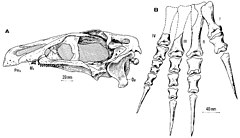 | |
| Skull and right pes of the holotype specimen MPC-D 100/111 | |
| Scientific classification | |
| Kingdom: | Animalia |
| Phylum: | Chordata |
| Clade: | Dinosauria |
| Clade: | Saurischia |
| Clade: | Theropoda |
| Superfamily: | †Therizinosauroidea |
| Family: | †Therizinosauridae |
| Genus: | †Erlikosaurus Barsbold & Perle, 1980 |
| Type species | |
| †Erlikosaurus andrewsi Barsbold & Perle, 1980 | |
| Synonyms | |
| |
Discovery and naming

The holotype specimen, MPC-D 100/111, was found in layers from the Bayshi Tsav locality on the Bayan Shireh Formation, consisting of an exceptionally well preserved skull, a virtually complete right pes only lacking the proximal end of metatarsals II, III and IV, and an almost complete left humerus. Other remains include some fragmentary cervical vertebrae, however, the count is not specified and they were not illustrated. These findings were made during a Soviet-Mongolian expedition in the Ömnögovi Province in 1972.[1][2] Eight years later, the genus and type species, Erlikosaurus andrewsi, was named and described (although very briefly) by paleontologists Rinchen Barsbold and Altangerel Perle in 1980, however, Barsbold was not indicated as the name-giver of this particular species. The generic name, Erlikosaurus, was taken from that of the demon king Erlik, from Turko-Mongolian mythology and the Greek σαῦρος (sauros, meaning lizard). The specific name, andrewsi, is in honour to the American paleontologist Roy Chapman Andrews, who was the leader of the American Asiatic Expeditions from 1922 to 1930.[1] Apparently, in the original description a left pes was claimed to be part of the holotype,[1] however, this statement has not been mentioned again.[2][3][4][5]
Confusingly, in 1981 Perle again named and described the species as if it were new, but this time in more detail and spelling the generic name as a Latinised "Erlicosaurus".[2] It is today widely accepted by most authors that the original name, Erlikosaurus, is valid. At the time of its discovery it was the only known therizinosaur (then called segnosaurs[6]) for which a complete skull had been discovered, this helped shed light on a puzzling and poorly known group of dinosaurs. It still represents the most completely known therizinosaurian skull.[4][5]
In 2010, Gregory S. Paul challenged the validity of this taxon, arguing that Erlikosaurus may be synonymous with Enigmosaurus (named in 1983[7]), since the remains of the latter were found in the same geologic formation, and only known from pelvic remains, whereas the pelvis in Erlikosaurus is unknown; this would make Enigmosaurus a junior synonym of Erlikosaurus.[8] However, since the holotype hip of Enigmosaurus did not closely resemble that of the specimen in Segnosaurus as would be expected for the Segnosaurus-like remains of Erlikosaurus, and there is a considerable size difference, paleontologist Rinchen Barsbold disputed the alleged synonymy.[9] Additional to this, the remains of Erlikosaurus and Enigmosaurus are known from upper and lower boundary, respectively.[3][7][10] Consequently, Enigmosaurus and Erlikosaurus are generally considered separated genera.[11]
Description
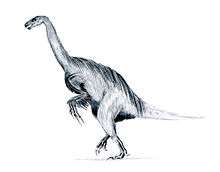
As the genus is only known from very fragmentary material, it has been problematic to determine the size of Erlikosaurus, especially as most of the vertebral column of the holotype is missing. The skull of the holotype specimen length is approximately 25 cm (250 mm) long, indicating a very small individual. Erlikosaurus may have been more lightly built than the ponderous Segnosaurus. Overall, Erlikosaurus were small-sized therizinosaurids, estimated to have reach about 3.4 m (11 ft) with weights between 227 to 454 kg (500 to 1,001 lb).[12] Nevertheless, Dodson have suggested a maximum length of 6 m (20 ft) long.[9] Gregory S. Paul proposed a more conservative length of 4.5 metres and a weight of 500 kg (1,100 lb).[13] In 2012 Stephan and colleagues used theropod-specific equations to estimate the body mass of Erlikosaurus and other therizinosaurs. However, since the femur is unknown, they used bivariate regression analyses on log-transformed data for Erlikosaurus. The results ended up on a femoral length of 44.33 cm (443.3 mm) and a weight of 173.7 kg (383 lb). Given the uncertainties of these estimates, they established an overall mass range between 150 to 250 kg (330 to 550 lb).[5] It is currently known that therizinosaurs were feathered animals based on the preserved feather impressions in specimens of Beipiaosaurus and Jianchangosaurus, so it is likely that Erlikosaurus were feathered as well.[14][15]
Crania
.png)
The most studied element from the holotype specimen of Erlikosaurus is the articulated and complete skull. The snout is moderately elongated,[1] with a premaxilla featuring elongated nasal processes. A fine, vertical lamina of bone is connected rostrally to the medial margin of the premaxilla, indicating that when the animal was alive, a cartilaginous internasal septum was present. Additional to this, the premaxilla features lateral and medial foramina that are connected by a complex system of vascular canals, which pervades the structure of the premaxilla and is probably associated with the sensory branches of the neurovasculature and ophthalmic nerve supporting the rhamphotheca (beak). The maxilla is triangular in shape and preserves 24 alveoli, the teeth are homodont with coarse serrations. The dentary is wedge-shaped elongated and preserves 31 alveoli. In a dorsal view, it is U-shaped and flattened at the back with an expansion lying across. The lateral and ventral surfaces in the symphyseal region bears a series of foramina that measure 2 to 5 mm (0.20 to 0.50 cm) in diameter. Isolated foramina are connected internally by a complex neurovascular canal. When restored, the skull measures 26 cm (260 mm) long and the mandible is about 24 cm (240 mm).[16]
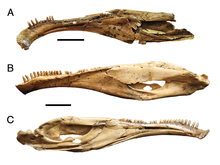
The well preserved braincase is very much complete, only missing the sphenethmoid-mesethmoid complex, whereas the laterosphenoids and orbitosphenoids are incompletely preserved in medial view. The bones around the braincase are strongly coossified, but the sutures between individual elements are not visible superficially, except for a few areas.[3] However, these internal sutures can be traced in CT scans and therefore, braincase elements could be differentiated one from other.[16] The restored brain of the specimen is somewhat elongated. The olfactory apparatus and the cerebral hemispheres are very notorious, with the olfactory tract being far larger than the actual brain. The cerebral hemispheres are large and broad. Interestingly, on the cerebral surface complex vascular grooves can be found, which are typically found in birds and mammals, as well as other dinosaurs. Lastly, the cerebellum is not very notorious as previous elements, it is elongated and stocky.[5]
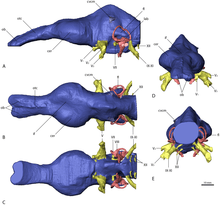
Keratinous beaks, or rhamphothecae, are well documented among diverse groups within the Dinosauria.[16] Ornithomimosaurs have solid evidence for it.[17][18] However, this is not an indicative to suggest the lack of this anatomical feature in other groups. Several characteristics are indicative of a rhamphothecae, such as an edentulous premaxilla with a thin, tapering lower edge, the successive loss of maxillary and dentary teeth, a mandibular concavity in the lower side, the displacement of the lower surface in the dentary, and a rostral projection of the mandibular symphysis.[16]
In Erlikosaurus, the presence of a keratinous beak on the maxilla and premaxilla can be inferred by the presence of numerous neurovascular foramina on the rostral and lateral surfaces in the skull, furthermore, it bears all the mentioned features above, however, it is unclear the extension of the beak.[16] The preserved rhamphotheca in specimens of Gallimimus and Ornithomimus evidences that the keratin sheath covered the premaxilla and overlapped it on the lower side by a few millimeters.[17] In some extant birds, the rhamphotheca is typically restricted to the premaxilla and maxilla, although in some cases it partially covers the nasal process in some birds.[19] Apparently, in Erlikosaurus the rhamphotheca covered the nasal process of the premaxilla.[16]
Postcrania
.png)
Body remains of Erlikosaurus are very sparse compared to the cranial elements, consisting of a humerus, a right foot and some cervical vertebrae. The particular cervicals were not figured and counted but briefly described. The cervicals are platycoelus (slightly concave at both ends) with low neural arches.[1] Being relatively robust, they have thick prezygapophyses and large parapophyses. Additional, the cervicals show some resemblance to those of Segnosaurus, however, being much smaller.[2]
The preserved right pes is virtually complete, only missing the proximal end of the metatarsals II, III and IV. It is shortened in length, with robust metatarsals that bear widened articular extremities, and form a non-compact metatarsus. The metatarsal I is the shortest in comparison, it measures 7 cm (70 mm) long and expands the laterally extended proximal articular surface of the metatarsus. All of the remaining metatarsals, are somewhat equal in size, metatarsal II covers 11 cm (110 mm) in length. The pedal digits are very peculiar in structure; the first digit is reduced in length, with all the remaining digits being nearly equal in length, however the fourth digit is very thin compared to the others. The phalanges of the three first digits are shortened, robust with comparable structure. The second and third phalanx of fourth digit are discoidal and stocky. Lastly, the unguals are recurved, exceptionally large, and strongly flattened laterally.[1][2] Gregory S. Paul surmised that the long, slender claws of the feet were used for self-defence mechanism.[13]
The left humerus is the only preserved remain from the pectoral region. The humerus shows an elongated epiphyses and a relatively large deltoideal process.[1] It is robust with an estimated length of 30 cm (300 mm). It has a reduced shaft. The proximal end of the humeurs is greatly broad. The humeral head features an articular surface that is convex and broad, in the middle it is reduced toward the margins. A prominent deltopectoral crest is present with the top located 1/3 at the length of the humerus from the proximal end. The articulation condyles for the radius and ulna are differentiated and divided by a shortened, furrow-like fossa and overall, they are very reduced in size. The fossa for the ulnar process is moderately deep and wide. The internal roughness of the head is prominent,[2] as in the unrelated Dromaeosauridae.[20]
Classification

Erlikosaurus was by Perle assigned to the Segnosauridae,[1] a group today known as the Therizinosauridae, confirmed by later cladistic analyses.[4] Therizinosaurs were a strange group of theropods that ate plants instead of meat, and had a backward-facing pubis, like ornithischians. Also like ornithischians, their jaws were tipped by a broad rounded bony beak useful for cropping off plants.[9][4]
The relationships of therizinosaurs were quite complicated when the first members were discovered. As an example, the first known therizinosaur taxon, Therizinosaurus, was interpreted to represent turtle-like animals that used the elongated claws to feed on seaweed.[21] However, in 1970, Rozhdestvensky proposed the idea that therizinosaurs (then known as segnosaurs) instead of being non-dinosaur creatures, they were in fact, theropods.[22] Later, in 1980, segnosaurs were thought to be slow, semiaquatic animals, with this, Gregory S. Paul claimed that these controversial animals had no theropod characteristics and they were prosauropods with ornithischian adaptations, also, they shared evolutionary relationships.[23] However, with the description of more genera such as Alxasaurus,[24] Nanshiungosaurus,[25] and the redescription of the skull of Erlikosaurus, more theropod evidence began to be supported.[3] With the discovery and description of the feathered Beipiaosaurus, therizinosaurs were utterly recognized as theropods, and started to be reconstructed in an accurate, bipedal posture.[14]
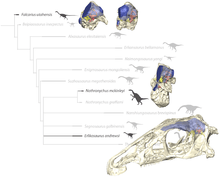
Consequently, therizinosaurs are now classified as theropods, within the Coelurosauria. Lindsay Zanno was one of the first authors in examine with detail the relationships and affinites of therizinosaurs. Most of her work have been useful in many conducted phylogenetic analysis.[4] The cladogram below is the result of the recently performed phylogenetic analysis of the Therizinosauria by Hartman et al. 2019 using the data provided by Zanno in 2010. Erlikosaurus occupied a very derived position in a clade formed with Nothronychus:[11]
| Therizinosauria |
| |||||||||||||||||||||||||||||||||||||||||||||||||||||||||||||||||||||||||||||||||||||||||||||||||||||||||||||||
Paleobiology

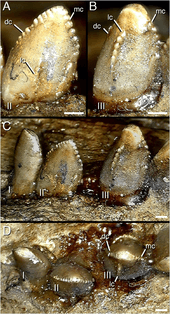
Erlikosaurus is poorly known from postcranial material, but the holotype skull became the focus of study in Computed Tomography (CT) scans that were published back in 2012 by the paleontologist Stephan Lautenschlager and Dr Emily Rayfield of Bristol University School of Earth Sciences, Professor Lindsay Zanno of the North Carolina Museum of Natural History and North Carolina State University, and Lawrence Witmer, Chang Professor of Paleontology at the Ohio University Heritage College of Osteopathic Medicine. Analysis of the brain cavity revealed that Erlikosaurus, and quite likely most other therizinosaurids, had well developed senses of smell, hearing, and balance, traits better associated with carnivorous theropods. The enlarged forebrain of Erlikosaurus may also have been useful in complex social behavior and predator evasion. These senses were also well-developed in earlier coelurosaurs and other theropods, indicating that therizinosaurs may have inherited many of these traits from their carnivorous ancestors and used them for their different and specialized dietary purposes.[5]
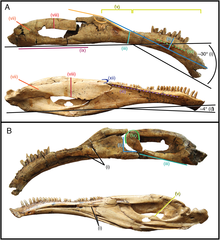
In 2013, Lautenschlager performed digital reconstructions for the cranial musculature in Erlikosaurus and found the bite force of Edmontosaurus being greater than that for the former. The lesser bite force for Erlikosaurus better served in stripping and cropping leaves, rather than active mastication.[26] Additional to this, the prominent rhamphotheca (keratinous beak) in the jaws acted as a stress-mitigating structure. Keratin beaks were in fact beneficial to enhance the stability of the skull making it less susceptible to bending and/or deformation during feeding.[27] The well preserved jaws also allowed a study by the University of Bristol to determine how its feeding style and dietary preferences were linked to how wide they could open the mouth. In the study, performed by Lautenshlager and colleagues in 2015, it was revealed that Erlikosaurus could open their mouth to a 43 degree angle at maximum. Also included in the study for comparison were the carnivorous theropods Allosaurus and Tyrannosaurus. From the comparisons, it was indicated that carnivorous dinosaurs had wider jaw gapes than herbivores, much as modern carnivorous animals do today.[28]
In 2016, using Finite Element Analysis (FEA) and a Multibody Dynamics Analysis (MDA), the bite forces of Erlikosaurus, Plateosaurus and Stegosaurus were tested in order to estimate dietary habits. The resulting bite force for Erlikosaurus was between 50–121 N, with a skull characterised by high susceptibility to stress and deformation. This indicates a feeding behaviour that was specialised in an active use of the beak. Erlikosaurus may have relied on postcranial musculature to compensate the low bite force and to relieve stresses on cranial structure, this is consistent with a herbivorous diet as suggested by other authors and this study.[29] Based on comparisons between the highly specialized mandibles in Segnosaurus and the simple one from Erlikosaurus, these taxa were separated by niche partitioning. For instance, the holotype mandible of Segnosaurus features very complex specializations, such as a gracile, recurved dentary, and a thickened lateral shelf. The dentition bears a triple carinae on the lower teeth, the teeth were foliodont (leaf-shaped) and bore enlarged, relatively tall, sideways compressed crowns with a slight recurvature at the upper margin of the tips. In contrast, the dentition of the holotype skull in Erlikosaurus seems to be more "standar", with a more simplistic morphology compared to the latter and other relatives.[30] In addition to these morphological differences, in 2019 Button and Zanno note that herbivorous dinosaurs followed two main distinct modes of feeding. One of these was processing food in the gut which is characterized by gracile skulls and relatively low bite forces. The second was oral food processing, characterized by features associated with extensive processing such as the lower jaws or dentition. Segnosaurus was found to be in the former mode, whereas Erlikosaurus was more likely to fall in the second group, indicating these two therizinosaurids were functionally separated and occupied different niches.[31]
Several discoveries about the reproduction in therizinosaurs have been made. The discovery of fossilized embryos at the Nanchao Formation and multiple egg nests from other formations indicates that therizinosaurs had a colonial nesting-style similar to other herbivores like some sauropodomorphs, titanosaurs and hadrosaurs, supporting a social life-style for these animals. Apparently, nestling therizinosaurs were capable of movement after birth and did not necessarily depend of their parents. It is also implied that therizinosaurs do not had a philopatric behaviour when nesting.[32][33][34]
Paleoecology

Erlikosaurus was unearthed from the Bayshi Tsav locality,[1] which represents part of the upper Bayan Shireh Formation.[3][10] This location is interpreted to have been dominated by fluvial environments, also, it is particularly abundant in hadrosauroid remains.[35] According to Averianov and Sues, based on biostratigraphic occurrences and datings, the Upper Bayan Shireh correlated the Iren Dabasu Formation.[36] The examination of the magnetostratigraphy of the formation seems to confirm that the entire Bayan Shireh lies within the Cretaceous Long Normal, which lasted only until the end of the Santonian stage.[37] In the recent redate of the formation performed by Kurumada and colleagues in 2020 based on powerful calcite U–Pb measurements, the age of the Bayan Shireh Formation was dated from 95.9 ± 6.0 million to 89.6 ± 4.0 million years ago, Cenomanian through Santonian ages.[38]
Fluvial, lacustrine and caliche-based boundary indicates a semi-arid environment and climate, with the presence of large rivers and lakes.[39][40][36] It is interpreded that during the times of the Bayan Shireh Formation, large rivers drained the eastern part of the Gobi Desert.[37] The Bayan Shireh Formation is generally considered to be lacustrine,[40] however, largescale cross-stratification in many of the sandstone layers at the Bayn Shireh and Burkhant localities seems to indicate a large meandering river[37] Many fossil fruits remains have been recovered from the Bor Guvé and Khara Khutul localities (Upper and Lower Bayan Shireh, respectively), indicating the presence of angiosperm plants.[41]
Erlikosaurus co-existed with a vast diversity of animals in the upper part of the formation, compromising dinosaur and non-dinosaur genera. Fellow dinosaurs include the medium-sized theropods Achillobator,[42] Garudimimus,[43] Segnosaurus[1] and possibly Alectrosaurus[44]. The ankylosaurs Talarurus and Tsagantegia.[45] Small marginocephalians Amtocephale[46] and Graciliceratops.[47] The hadrosauroids Gobihadros,[10] and the sauropods Erketu.[41][48] Other fauna includes the turtles Lindholmemys,[49] crocodylomorphs Paralligator,[50] unnamed azhdarchids[51] and the primitive sharks Hybodus.[36]
See also
References
- Barsbold, R.; Perle, A. (1980). "Segnosauria, a new suborder of carnivorous dinosaurs" (PDF). Acta Palaeontologica Polonica. 25 (2): 190–192.
- Perle, A. (1981). "Novyy segnozavrid iz verkhnego mela Mongolii" [New Segnosauridae from the Upper Cretaceous of Mongolia]. Transactions of the Joint Soviet-Mongolian Paleontological Expedition (in Russian). 15: 50–59. Translated paper
- Clark, J. M.; Perle, A.; Norell, M. (1994). "The skull of Erlicosaurus andrewsi, a Late Cretaceous "Segnosaur" (Theropoda, Therizinosauridae) from Mongolia". American Museum Novitates. 3115: 1–39. hdl:2246/3712.
- Zanno, L. E. (2010). "A taxonomic and phylogenetic re-evaluation of Therizinosauria (Dinosauria: Maniraptora)". Journal of Systematic Palaeontology. 8 (4): 503–543. doi:10.1080/14772019.2010.488045.
- Stephan, L.; Emily, J. R.; Perle, A.; Lindsay, E. Z.; Lawrence, M. W. (2012). "The Endocranial Anatomy of Therizinosauria and Its Implications for Sensory and Cognitive Function". PLOS ONE. 7 (12): e52289. Bibcode:2012PLoSO...752289L. doi:10.1371/journal.pone.0052289. PMC 3526574. PMID 23284972.
- Perle, A. (1979). "Segnosauridae — novoe semejstvo teropod iz pozdnego mela Mongolii" [Segnosauridae — a new family of theropods from the Late Cretaceous of Mongolia]. Transactions of the Joint Soviet-Mongolian Paleontological Expedition (in Russian). 8: 45–55. Translated paper
- Barsbold, R. (1983). "Хищные динозавры мела Монголии" [Carnivorous dinosaurs from the Cretaceous of Mongolia] (PDF). Transactions of the Joint Soviet-Mongolian Paleontological Expedition (in Russian). 19: 107. Translated paper
- Paul, G. S. (2010). The Princeton Field Guide to Dinosaurs. Princeton University Press. p. 159. ISBN 978-0-6911-3720-9.
- Dodson, P. (1993). "Erlikosaurus". The Age of Dinosaurs. Publications International, LTD. p. 142. ISBN 0-7853-0443-6.
- Tsogtbaatar, K.; Weishampel, D. B.; Evans, D. C.; Watabe, M. (2019). "A new hadrosauroid (Dinosauria: Ornithopoda) from the Late Cretaceous Baynshire Formation of the Gobi Desert (Mongolia)". PLOS ONE. 14 (4): e0208480. Bibcode:2019PLoSO..1408480T. doi:10.1371/journal.pone.0208480. PMC 6469754. PMID 30995236.
- Hartman, S.; Mortimer, M.; Wahl, W. R.; Lomax, D. R.; Lippincott, J.; Lovelace, D. M. (2019). "A new paravian dinosaur from the Late Jurassic of North America supports a late acquisition of avian flight". PeerJ. 7: e7247. doi:10.7717/peerj.7247. PMC 6626525. PMID 31333906.
- Holtz, T. R.; Rey, L. V. (2007). Dinosaurs: The Most Complete, Up-to-Date Encyclopedia for Dinosaur Lovers of All Ages. Random House. ISBN 9780375824197.CS1 maint: date and year (link) Genus List for Holtz 2012 Weight Information
- Paul, G. S. (2016). The Princeton Field Guide to Dinosaurs (2nd ed.). Princeton, New Jersey: Princeton University Press. pp. 162–168. ISBN 9780691167664.
- Xu, X.; Tang, Z.; Wang, X. A. (1999). "A therizinosauroid dinosaur with integumentary structures from China". Nature. 339 (6734): 350–354. Bibcode:1999Natur.399..350X. doi:10.1038/20670.
- Pu, H.; Kobayashi, Y.; Lü, J.; Xu, L.; Wu, Y.; Chang, H.; Zhang, J.; Jia, S. (2013). "An Unusual Basal Therizinosaur Dinosaur with an Ornithischian Dental Arrangement from Northeastern China". PLOS ONE. 8 (5): e63423. Bibcode:2013PLoSO...863423P. doi:10.1371/journal.pone.0063423. PMC 3667168. PMID 23734177.
- Stephan, L.; Lawrence, M. W.; Perle, A.; Lindsay, E. Z.; Emily, J. R. (2014). "Cranial anatomy of Erlikosaurus andrewsi (Dinosauria, Therizinosauria): new insights based on digital reconstruction". Journal of Vertebrate Paleontology. 34 (6): 1263–1291. doi:10.1080/02724634.2014.874529.
- Norell, M. A.; Makovicky, P. J.; Currie, P. J. (2001). "The beak of ostrich dinosaurs". Nature. 412 (6850): 873–874. Bibcode:2001Natur.412..873N. doi:10.1038/35091139. PMID 11528466.
- Barrett, P. M. (2005). "The diet of ostrich dinosaurs". Palaeontology. 48 (2): 347–358. doi:10.1111/j.1475-4983.2005.00448.x.
- Knutsen, E. M. (2007). Beak morphology in extant birds with implications on beak morphology in ornithomimids (PDF). University of Oslo. p. 44.
- Ostrom, J. H. (1969). "Osteology of Deinonychus antirrhopus, an Unusual Theropod from the Lower Cretaceous of Montana" (PDF). Peabody Museum of Natural History Bulletin. 30: 1–165.
- Maleev, E. A. (1954). "Noviy cherepachoobrazhniy yashcher v Mongolii" [New turtle−like reptile in Mongolia]. Priroda (3): 106–108. Translated paper
- Rozhdestvensky, A. K. (1970). "On the gigantic claws of mysterious Mesozoic reptiles". Paleontologicheskii Zhurnal (in Russian) (1): 131–141.
- Paul, G. S. (1984). "The segnosaurian dinosaurs: relics of the prosauropod-ornithischian transition?". Journal of Vertebrate Paleontology. 4 (4): 507–515. doi:10.1080/02724634.1984.10012026. ISSN 0272-4634. JSTOR 4523011.
- Russell, D. A.; Dong, Z. (1993). "The affinities of a new theropod from the Alxa Desert, Inner Mongolia, People's Republic of China". Canadian Journal of Earth Sciences. 30 (10): 2107–2127. Bibcode:1993CaJES..30.2107R. doi:10.1139/e93-183.
- Dong, Z. (1979). Dinosaurs from the Cretaceous of South China (PDF) (in Chinese). Mesozoic and Cenozoic Red Beds of South China, Science Press. pp. 342–350.
- Stephan, L. (2013). "Cranial myology and bite force performance of Erlikosaurus andrewsi : a novel approach for digital muscle reconstructions". Journal of Anatomy. 222 (2): 260−272. doi:10.1111/joa.12000. PMC 3632231. PMID 23061752.
- Stephan, L.; Lawrence, M. W.; Perle, A.; Emily, J. R. (2013). "Biomechanical innovations in dinosaurs". Proceedings of the National Academy of Sciences. 110 (51): 20657–62. doi:10.1073/pnas.1310711110. PMC 3870693. PMID 24297877.
- Stephan, L. (2015). "Estimating cranial musculoskeletal constraints in theropod dinosaurs". Royal Society Open Science. 2 (11): 150495. Bibcode:2015RSOS....250495L. doi:10.1098/rsos.150495. PMC 4680622. PMID 26716007.
- Stephan, L.; Brassey, C. A.; Button, D. J.; Barrett, P. M. (2016). "Decoupled form and function in disparate herbivorous dinosaur clades". Nature. 26495: 26495. Bibcode:2016NatSR...626495L. doi:10.1038/srep26495. PMC 4873811. PMID 27199098.
- Zanno, L. E.; Tsogtbaatar, K.; Chinzorig, T.; Gates, T. A. (2016). "Specializations of the mandibular anatomy and dentition of Segnosaurus galbinensis (Theropoda: Therizinosauria)". PeerJ. 4: e1885. doi:10.7717/peerj.1885. PMC 4824891. PMID 27069815.
- Button, D. J.; Zanno, L. E. (2019). "Repeated evolution of divergent modes of herbivory in non-avian dinosaurs". Current Biology. 30 (1): 158−168.e4. doi:10.1016/j.cub.2019.10.050. PMID 31813611.
- Watabe, M.; Ariunchimeg, Y.; Brinkman, D. (1997). "Dinosaur egg nests and their sedimentary environments in the Bayn Shire locality (Late Cretaceous), eastern Gobi". Mongolia–Japan Joint Paleontological Expedition. Abstract of Report Meeting: 11.
- Kundrát, M.; Cruickshank, A. R. I.; Manning, T. W.; Nudds, J. (2007). "Embryos of therizinosauroid theropods from the Upper Cretaceous of China: diagnosis and analysis of ossification patterns". Acta Zoologica. 89 (3): 231–251. doi:10.1111/j.1463-6395.2007.00311.x.
- "First record of a dinosaur nesting colony from Mongolia reveals nesting behavior of therizinosauroids". Hokkaido University. 2013.
- Ishigaki, S.; Tsogtbaatar, K.; Saneyoshi, M.; Mainbayar, B.; Aoki, K.; Ulziitseren, S.; Imayama, T.; Takahashi, A.; Toyoda, S.; Bayardorj, C.; Buyantegsh, B.; Batsukh, J.; Purevsuren, B.; Asai, H.; Tsutanaga, S.; Fujii, K. (2016). "Report of the Okayama University of Science - Mongolian Institute of Paleontology and Geology Joint Expedition in 2016" (PDF). Bulletin of Research Institute of Natural Sciences (42): 33–46.
- Averianov, A.; Sues, H. (2012). "Correlation of Late Cretaceous continental vertebrate assemblages in Middle and Central Asia" (PDF). Journal of Stratigraphy. 36 (2): 462–485.
- Hicks, J. F.; Brinkman, D. L.; Nichols, D. J.; Watabe, M. (1999). "Paleomagnetic and palynologic analyses of Albian to Santonian strata at Bayn Shireh, Burkhant, and Khuren Dukh, eastern Gobi Desert, Mongolia". Cretaceous Research. 20 (6): 829–850. doi:10.1006/cres.1999.0188.
- Kurumada, Y.; Aoki, S.; Aoki, K.; Kato, D.; Saneyoshi, M.; Tsogtbaatar, K.; Windley, B. F.; Ishigaki, S. (2020). "Calcite U–Pb age of the Cretaceous vertebrate‐bearing Bayn Shire Formation in the Eastern Gobi Desert of Mongolia: usefulness of caliche for age determination". Terra Nova. doi:10.1111/ter.12456.
- Martinson, G. G. (1982). "The Upper Cretaceous mollusks of Mongolia". Sovmestnaya Sovetsko– Mongolskaya Paleontolog-icheskaya Ekspeditsia. 17: 5–76.
- Samoilov, V. S.; Benjamini, C. (1996). "Geochemical features of dinosaur remains from the Gobi Desert, South Mongolia". PALAIOS. 11 (6): 519–531. Bibcode:1996Palai..11..519S. doi:10.2307/3515188. JSTOR 3515188.
- Ksepka, D. T.; Norell, M. A. (2006). "Erketu ellisoni, a long-necked sauropod from Bor Guvé (Dornogov Aimag, Mongolia)" (PDF). American Museum Novitates. 3508 (1): 1–16. doi:10.1206/0003-0082(2006)3508[1:EEALSF]2.0.CO;2.
- Perle, A.; Norell, M. A.; Clark, J. (1999). "A new maniraptoran Theropod - Achillobator giganticus (Dromaeosauridae) - from the Upper Cretaceous of Burkhant, Mongolia". Contributions from the Geology and Mineralogy Chair, National Museum of Mongolia (101): 1–105. OCLC 69865262.
- Kobayashi, Y.; Barsbold, R. (2005). "Reexamination of a primitive ornithomimosaur, Garudimimus brevipes Barsbold, 1981 (Dinosauria: Theropoda), from the Late Cretaceous of Mongolia". Canadian Journal of Earth Sciences. 42 (9): 1501–1521. doi:10.1139/e05-044. hdl:2115/14579.
- Perle, A. (1977). "O pervoy nakhodke Alektrozavra (Tyrannosauridae, Theropoda) iz pozdnego Mela Mongolii" [On the first discovery of Alectrosaurus (Tyrannosauridae, Theropoda) in the Late Cretaceous of Mongolia]. Shinzhlekh Ukhaany Akademi Geologiin Khureelen (in Russian). 3 (3): 104–113.
- Park, J. (2020). "Additional skulls of Talarurus plicatospineus (Dinosauria: Ankylosauridae) and implications for paleobiogeography and paleoecology of armored dinosaurs". Cretaceous Research. 108: e104340. doi:10.1016/j.cretres.2019.104340.
- Watabe, M.; Tsogtbaatar, K.; Sullivan, R. M. (2011). "A new pachycephalosaurid from the Baynshire Formation (Cenomanian-late Santonian), Gobi Desert, Mongolia" (PDF). Fossil Record 3. New Mexico Museum of Natural History and Science, Bulletin. 53: 489–497.
- Sereno, P. C. (2000). "The fossil record, systematics and evolution of pachycephalosaurs and ceratopsians from Asia" (PDF). The Age of Dinosaurs in Russia and Mongolia. Cambridge University Press. pp. 489–491.
- Jerzykiewicz, T.; Russell, D. A. (1991). "Late Mesozoic stratigraphy and vertebrates of the Gobi Basin". Cretaceous Research. 12 (4): 345–377. doi:10.1016/0195-6671(91)90015-5.
- Sukhanov, V. B.; Danilov, I. G.; Syromyatnikova, E. V. (2008). "The Description and Phylogenetic Position of a New Nanhsiungchelyid Turtle from the Late Cretaceous of Mongolia". Acta Palaeontologica Polonica. 53 (4): 601–614. doi:10.4202/app.2008.0405.
- Turner, A. H. (2015). "A Review of Shamosuchus and Paralligator (Crocodyliformes, Neosuchia) from the Cretaceous of Asia". PLOS ONE. 10 (2): e0118116. Bibcode:2015PLoSO..1018116T. doi:10.1371/journal.pone.0118116. PMC 4340866. PMID 25714338.
- Watabe, M.; Suzuki, D.; Tsogtbaatar, K. (2009). "The first discovery of pterosaurs from the Upper Cretaceous of Mongolia" (PDF). Acta Palaeontologica Polonica. 54 (2): 231–242. doi:10.4202/app.2006.0068.
External links
| Wikimedia Commons has media related to Erlikosaurus. |

















